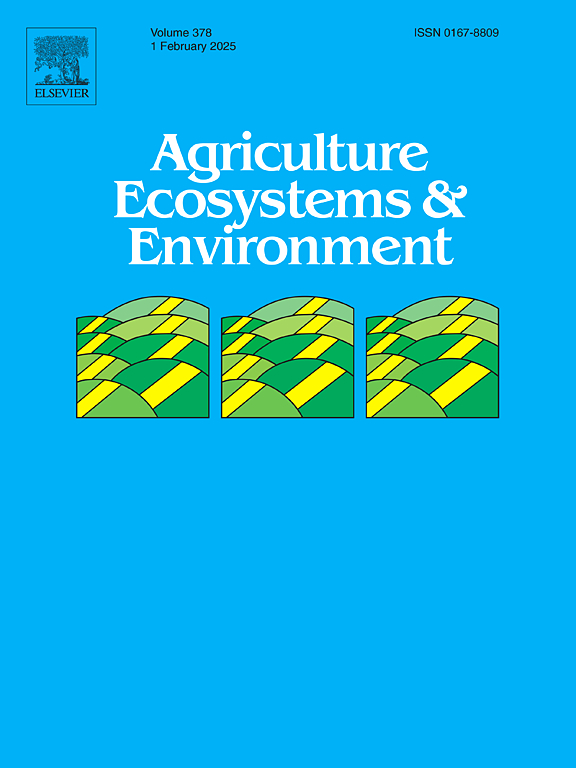Enhanced multifunctionality of sandy loam soil with co-application of biochar and organic manure is driven by microbial network complexity rather than community diversity
IF 6
1区 农林科学
Q1 AGRICULTURE, MULTIDISCIPLINARY
引用次数: 0
Abstract
Despite the prevalent application of biochar and organic manure in agro-ecosystems, their combined effects on the restoration of sandy soils mediated by microbial mechanisms remain understudied. Here, we conducted a field experiment in the Mu Us sandy land to characterize the responses of soil microbiomes (bacteria, fungi, protists) and ecosystem functions (soil fertility, plant growth, material cycling, carbon mineralization potential) to co-application of biochar and organic manure with planting. The experiment incorporated three levels of biochar (0, 25, 50 t/hm2), two levels of organic manure (0, 10 t/hm2), and four levels of plants (1, 3, 5, 9 legume or grass species). The results indicated that both biochar and organic manure, but not plants, contributed to significant enhancement in soil multifunctionality. The greatest soil multifunctionality was observed at the high biochar rate with organic manure, which increased by 52 % compared to the lowest multifunctionality observed under no application of biochar and organic manure. This was manifested by increased contents of soil organic carbon (761 %), total nitrogen (207 %), and total phosphorus (67 %), alongside stimulated plant growth, despite greater carbon mineralization potential. Various microbial communities exhibited differential responses to biochar and organic manure treatments, with decrease in bacterial diversity and increase in protistan diversity. Fungal diversity positively responded to biochar application rate only. Soil organic carbon, total nitrogen, and total phosphorus emerged as the primary factors driving shifts in bacterial, fungal, and protistan communities. The complexity of microbial networks varied across treatments and positively correlated with the rate of organic manure (bacteria), biochar (fungi), or both (protist), but there was no response to planting. Linear regression analysis revealed a negative correlation between bacterial diversity and soil multifunctionality (R2 = 0.14, p < 0.01). Protistan diversity (R2 = 0.14, p < 0.01) and microbial network complexity (bacteria: R2 = 0.25, p < 0.001; fungi: R2 = 0.13, p < 0.01; protists: R2 = 0.36, p < 0.001) were positively correlated with soil multifunctionality. Variance partitioning analysis indicated that microbial network complexity had a greater influence on soil multifunctionality than community diversity, underscoring the role of microbial interactions. Our results indicate that the co-application of biochar and organic manure, not plants, enhances the multifunctionality of sandy loam soil, with microbiome complexity serving as a critical predictor of changes in soil functions.
生物炭与有机肥混施对沙壤土多功能性的增强是由微生物网络复杂性而非群落多样性驱动的
尽管生物炭和有机肥在农业生态系统中应用广泛,但它们在微生物机制下对沙质土壤恢复的综合效应仍未得到充分研究。以毛乌素沙地为研究对象,研究了土壤微生物组(细菌、真菌、原生生物)和生态系统功能(土壤肥力、植物生长、物质循环、碳矿化潜力)对生物炭和有机肥配施与种植的响应。试验包括3个水平的生物炭(0、25、50 t/hm2), 2个水平的有机肥(0、10 t/hm2)和4个水平的植物(1、3、5、9种豆科或禾草)。结果表明,生物炭和有机肥对土壤多功能性有显著的促进作用,而植物对土壤多功能性没有显著的促进作用。在施用有机肥和生物炭时,土壤的多功能性最高,比不施用有机肥和生物炭时的土壤多功能性最低提高了52. %。这表现在土壤有机碳(761 %)、全氮(207 %)和全磷(67 %)含量增加,同时刺激了植物生长,尽管碳矿化潜力更大。不同的微生物群落对生物炭和有机肥处理表现出不同的响应,细菌多样性降低,原生菌多样性增加。真菌多样性仅与生物炭施用量呈正相关。土壤有机碳、全氮和全磷是驱动细菌、真菌和原生生物群落变化的主要因素。不同处理下微生物网络的复杂性不同,并与有机肥(细菌)、生物炭(真菌)或两者(原生生物)的比例呈正相关,但对种植没有响应。线性回归分析显示细菌多样性与土壤多功能性呈负相关(R2 = 0.14, p <; 0.01)。原生生物多样性(R2 = 0.14, p <; 0.01)和微生物网络复杂性(细菌:R2 = 0.25, p <; 0.001;真菌:R2 = 0.13, p <; 0.01;原生生物:R2 = 0.36, p <; 0.001)与土壤多功能性呈正相关。方差划分分析表明,微生物网络复杂性对土壤多功能性的影响大于群落多样性,强调了微生物相互作用的作用。我们的研究结果表明,生物炭和有机肥的共同施用,而不是植物,增强了沙壤土的多功能性,微生物群复杂性是土壤功能变化的关键预测因子。
本文章由计算机程序翻译,如有差异,请以英文原文为准。
求助全文
约1分钟内获得全文
求助全文
来源期刊

Agriculture, Ecosystems & Environment
环境科学-环境科学
CiteScore
11.70
自引率
9.10%
发文量
392
审稿时长
26 days
期刊介绍:
Agriculture, Ecosystems and Environment publishes scientific articles dealing with the interface between agroecosystems and the natural environment, specifically how agriculture influences the environment and how changes in that environment impact agroecosystems. Preference is given to papers from experimental and observational research at the field, system or landscape level, from studies that enhance our understanding of processes using data-based biophysical modelling, and papers that bridge scientific disciplines and integrate knowledge. All papers should be placed in an international or wide comparative context.
 求助内容:
求助内容: 应助结果提醒方式:
应助结果提醒方式:


